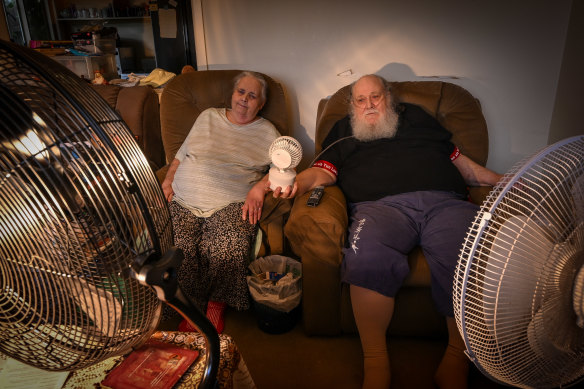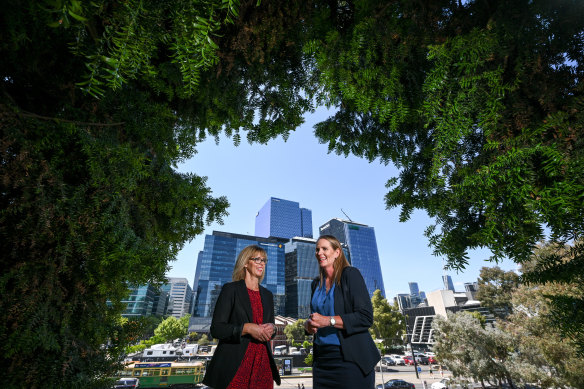By Cara Waters
People in Melbourne’s poorest suburbs feel the heat more intensely than those in more affluent areas, largely due to urban heat islands created by badly designed buildings, roads and footpaths.
Analysis shows temperatures can vary as much as six degrees across different parts of the city, particularly in the north and west, where one expert says the islands have grown big enough to become “heat continents”.

Stuart and Robyn Chubb live in a rental house that gets as “hot as an oven”.Credit: Eddie Jim
Emma Bacon, executive director of not-for-profit group Sweltering Cities, said this week a person’s suburb and type of housing were two of the biggest indicators of heat vulnerability.
“In the north and west [of Melbourne], people are acutely aware that the way their suburbs are built is increasing the heat,” she said.
“They are looking at treeless streets, they’re looking at lots of dark surfaces, they’re looking at new developments that aren’t preserving any sort of cool corridors.”
In urban environments, tree cover and green space cool temperatures, while large amounts of asphalt and concrete absorb and radiate solar energy.
Bacon said some of the heat islands were getting so large they had become “heat continents”.
The latest available analysis, led by the Clean Air and Urban Landscapes Hub in 2019, found the councils of Brimbank, Casey and Melton recorded the highest differences between land-surface temperatures and baseline temperatures.
In contrast, the more affluent coastal and leafy outer suburbs of the Mornington Peninsula and Yarra Ranges had the least difference.
Bacon said issues highlighted by the 2019 mapping would only have been exacerbated in the past few years. As climate change makes the weather hotter, the health risks associated with these heat islands would grow.
“We vastly underestimate the health impacts of heatwaves,” Bacon said. “It’s the biggest killer of any environmental disaster in Australia, and heat-related deaths are projected to double in Melbourne by 2050.”
Bacon said the quality of homes could have as big an effect as people’s suburbs.
In Donvale in Melbourne’s north-east, Stuart Chubb and his wife, Robyn, have seen their street cleared of many trees over the years as bigger houses are built.
The couple dreads the arrival of hot weather because their rented home, which is slated for demolition, has poor insulation and no proper air-conditioning.

City of Melbourne heat officers Tiffany Crawford and Krista Milne. Credit: Eddie Jim
“It can be like an oven, even with the fans on and a tiny portable air-conditioner,” Chubb said. “Both my wife and I have chronic lung disease and it seems to be affecting breathing for us. The heat has affected my wife so badly she has been in and out of hospital 15 times since Christmas.”
Melbourne experienced 15 days of extreme heat – classified as over 35 degrees – in 2019, an increase of seven days compared with the city’s annual average extreme heat days before 2010.
The city has had four extreme heat days already this year and by 2050 is expected to experience an annual average of 16 days greater than 35 degrees.
City of Melbourne is among the councils working to address increasing temperatures and the impact of heat islands. Last year, it appointed Australia’s first heat officers, Tiffany Crawford and Krista Milne.
Crawford said the dense environment of the city centre with more buildings and concrete meant it could be four to five degrees hotter than Melbourne’s greener suburbs. Poor and vulnerable people were the most likely to bear the brunt of the heat.
“It disproportionately impacts those who are vulnerable, particularly those experiencing homelessness in the city that don’t have somewhere perhaps to retreat to,” she said.
“We also know that those in social housing and people experiencing income stress may be having to make difficult choices about cooling their homes. If they even have access to air-conditioning, which many people do not.”
The City of Melbourne is planting 3000 trees each year to try to combat heat, with the ambition of reaching 27 per cent tree canopy cover by 2025. From June, it will trial planting trees on top of tram shelters in the CBD.
Other strategies the heat officers are investigating include permeable paving rather than hot surfaces that soak up water and the installation of misting fans in the city centre like those used at the Australian Open.
However, Bacon said more needed to be done. She called for a 40 per cent standard for tree canopy cover; the retrofitting of homes for people who are most vulnerable; and ensuring that rental minimum standards include not just heating in winter but also cooling in summer.
“The coming summer, whether it’s the one at the end of this year or in a few years from now, it’s going to be the hottest summer of our lives,” she said.

Credit: Matt Golding
“All the heatwaves we’ve experienced, all the hot nights, all the sweaty days are going to be nothing compared to what we’re going to feel, and we can either start dealing with that now by making our homes safe or we can wait until there is a really tragic heatwave.”
The Morning Edition newsletter is our guide to the day’s most important and interesting stories, analysis and insights. Sign up here.